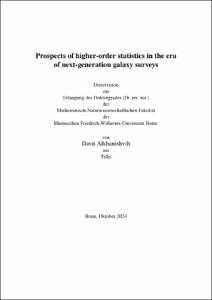Alkhanishvili, Davit: Prospects of higher-order statistics in the era of next-generation galaxy surveys. - Bonn, 2025. - Dissertation, Rheinische Friedrich-Wilhelms-Universität Bonn.
Online-Ausgabe in bonndoc: https://nbn-resolving.org/urn:nbn:de:hbz:5-82389
Online-Ausgabe in bonndoc: https://nbn-resolving.org/urn:nbn:de:hbz:5-82389
@phdthesis{handle:20.500.11811/13213,
urn: https://nbn-resolving.org/urn:nbn:de:hbz:5-82389,
author = {{Davit Alkhanishvili}},
title = {Prospects of higher-order statistics in the era of next-generation galaxy surveys},
school = {Rheinische Friedrich-Wilhelms-Universität Bonn},
year = 2025,
month = jul,
note = {In the last decades, the Λ cold dark matter model has been recognised as the standard model of cosmology due to its remarkable accuracy in explaining cosmological observations. The measurement of clustering signal from the large-scale structure using summary statistics like the power spectrum proved to be a useful tool in constraining the parameters of this standard model of cosmology. With the advent of upcoming next-generation galaxy surveys, which boast extensive volume coverage and high galaxy number density, the importance of higher-order statistics like the bispectrum is becoming more apparent in providing the potential for greatly improving current constraints on cosmological parameters. They also present additional computational and modelling challenges which this thesis aims to tackle. The study focuses particularly on modelling the bispectrum using the perturbation theory to enhance its role in extracting cosmological information beyond two-point statistics.
At first we present findings from testing next-to-leading order perturbation theory expansions of the matter power spectrum and the bispectrum using 𝑁-body simulations, with a focus on the effective field theory (EFT) of large-scale structure. Results reveal EFT as having the largest range of accuracy (reach) among perturbation theory models, showcasing its capability to capture small-scale non-linear effects. The impact of systematic and statistical errors on the model’s reach is also explored.
Next we introduce the use of deep neural networks to model the effect of survey geometry on galaxy power spectrum and bispectrum. The models demonstrate high accuracy (better than 0.1 per cent) and computational efficiency. The only challenge in such an approach is creating training datasets for the bispectrum, which requires significant time investment. However, this step can be accelerated using massive parallelisation and should not be a challenge in practical applications.
Lastly, the performance of a perturbative galaxy bias expansion up to third order is assessed against synthetic galaxy catalogues, which replicate the survey characteristics of the next-generation Euclid spectroscopic galaxy survey. We investigate up to which scales the combination of the real-space galaxy power spectrum and the bispectrum provide unbiased estimates of the fiducial cosmological parameters, how well these parameters are constrained. From these tests, it emerges that the combination of the galaxy power spectrum and the bispectrum modelled using the galaxy bias expansion can accurately extract the cosmological parameters up to a scale of 0.18 h Mpc-1. The study also demonstrates between 2-5 times more gain in the ability to constrain the cosmological parameters by including the bispectrum data over just using the power spectrum.},
url = {https://hdl.handle.net/20.500.11811/13213}
}
urn: https://nbn-resolving.org/urn:nbn:de:hbz:5-82389,
author = {{Davit Alkhanishvili}},
title = {Prospects of higher-order statistics in the era of next-generation galaxy surveys},
school = {Rheinische Friedrich-Wilhelms-Universität Bonn},
year = 2025,
month = jul,
note = {In the last decades, the Λ cold dark matter model has been recognised as the standard model of cosmology due to its remarkable accuracy in explaining cosmological observations. The measurement of clustering signal from the large-scale structure using summary statistics like the power spectrum proved to be a useful tool in constraining the parameters of this standard model of cosmology. With the advent of upcoming next-generation galaxy surveys, which boast extensive volume coverage and high galaxy number density, the importance of higher-order statistics like the bispectrum is becoming more apparent in providing the potential for greatly improving current constraints on cosmological parameters. They also present additional computational and modelling challenges which this thesis aims to tackle. The study focuses particularly on modelling the bispectrum using the perturbation theory to enhance its role in extracting cosmological information beyond two-point statistics.
At first we present findings from testing next-to-leading order perturbation theory expansions of the matter power spectrum and the bispectrum using 𝑁-body simulations, with a focus on the effective field theory (EFT) of large-scale structure. Results reveal EFT as having the largest range of accuracy (reach) among perturbation theory models, showcasing its capability to capture small-scale non-linear effects. The impact of systematic and statistical errors on the model’s reach is also explored.
Next we introduce the use of deep neural networks to model the effect of survey geometry on galaxy power spectrum and bispectrum. The models demonstrate high accuracy (better than 0.1 per cent) and computational efficiency. The only challenge in such an approach is creating training datasets for the bispectrum, which requires significant time investment. However, this step can be accelerated using massive parallelisation and should not be a challenge in practical applications.
Lastly, the performance of a perturbative galaxy bias expansion up to third order is assessed against synthetic galaxy catalogues, which replicate the survey characteristics of the next-generation Euclid spectroscopic galaxy survey. We investigate up to which scales the combination of the real-space galaxy power spectrum and the bispectrum provide unbiased estimates of the fiducial cosmological parameters, how well these parameters are constrained. From these tests, it emerges that the combination of the galaxy power spectrum and the bispectrum modelled using the galaxy bias expansion can accurately extract the cosmological parameters up to a scale of 0.18 h Mpc-1. The study also demonstrates between 2-5 times more gain in the ability to constrain the cosmological parameters by including the bispectrum data over just using the power spectrum.},
url = {https://hdl.handle.net/20.500.11811/13213}
}






